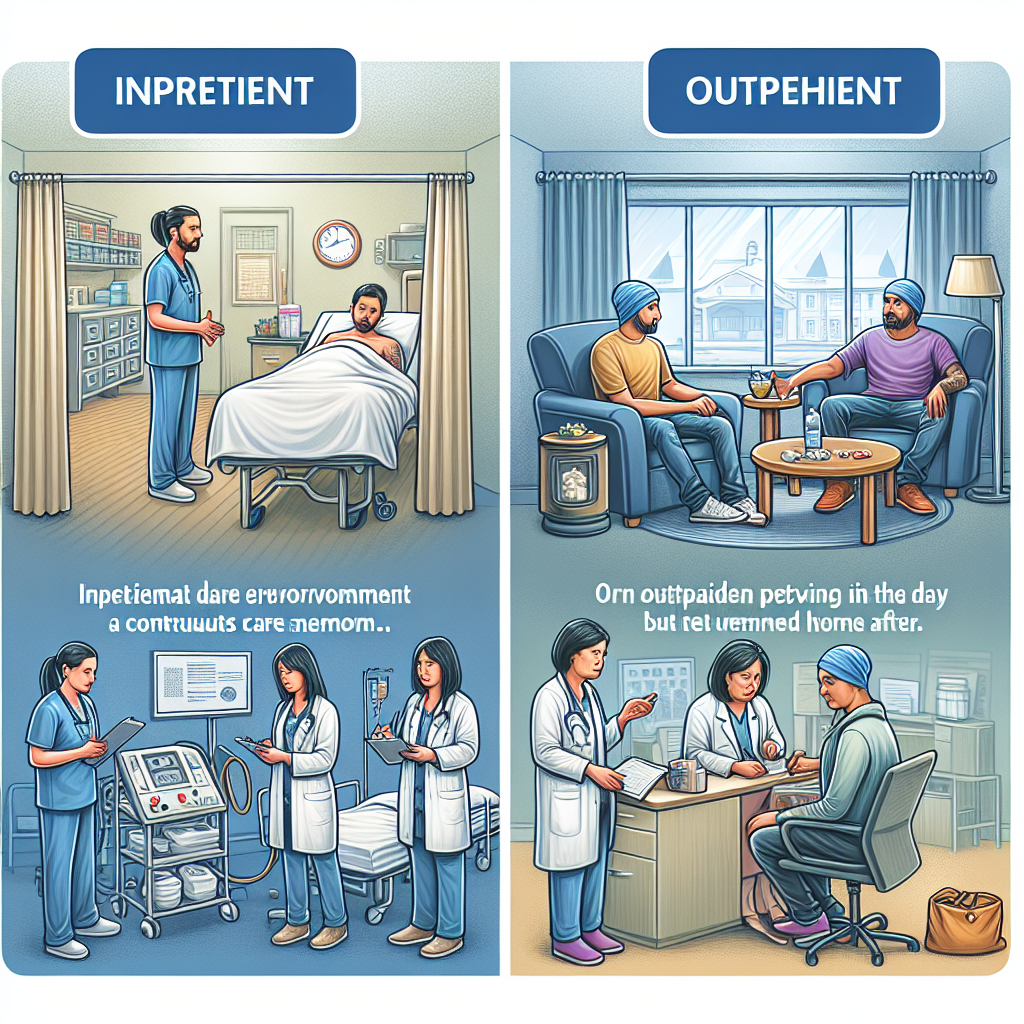-
Table of Contents

“Inpatient vs. Outpatient Drug Rehab: Intensive Care vs. Flexible Treatment.”
Introduction
Inpatient and outpatient drug rehab programs are two primary approaches to addiction treatment, each offering distinct structures, environments, and levels of care. Inpatient rehab, also known as residential treatment, requires patients to live at the treatment facility for the duration of their program, providing a highly structured and immersive environment. This setting allows for 24/7 medical supervision, intensive therapy sessions, and a focus on removing external triggers and distractions. Conversely, outpatient rehab allows patients to live at home while attending scheduled treatment sessions at a facility. This approach offers greater flexibility, enabling individuals to maintain work, school, or family commitments while receiving care. Outpatient programs vary in intensity, from partial hospitalization programs (PHPs) that require several hours of treatment per day, to standard outpatient programs with fewer weekly sessions. The choice between inpatient and outpatient rehab depends on various factors, including the severity of the addiction, the presence of co-occurring mental health disorders, and the individual’s personal and professional responsibilities. Understanding these differences is crucial for selecting the most appropriate treatment path for long-term recovery.
Key Differences Between Inpatient and Outpatient Drug Rehab Programs
When considering drug rehabilitation options, understanding the key differences between inpatient and outpatient programs is crucial for making an informed decision. Both types of programs aim to help individuals overcome addiction, but they do so in distinct ways, each with its own set of advantages and challenges. By exploring these differences, one can better determine which approach aligns with their personal needs and circumstances.
Inpatient drug rehab programs, often referred to as residential treatment, require individuals to live at the treatment facility for the duration of their program. This immersive environment provides a structured and supportive setting, which can be particularly beneficial for those with severe addictions or co-occurring mental health disorders. The round-the-clock care and supervision ensure that patients are constantly monitored, reducing the risk of relapse and providing immediate assistance in case of any medical or psychological emergencies. Additionally, the residential nature of inpatient rehab allows for a more intensive focus on therapy and recovery, with daily schedules often filled with individual counseling, group therapy sessions, and various therapeutic activities.
On the other hand, outpatient drug rehab programs offer a more flexible approach, allowing individuals to live at home while attending treatment sessions at a facility. This option is ideal for those who have responsibilities such as work, school, or family commitments that they cannot abandon. Outpatient programs vary in intensity, ranging from standard outpatient care to more rigorous partial hospitalization programs (PHPs) and intensive outpatient programs (IOPs). These programs typically involve several hours of therapy and support each week, providing a balance between treatment and everyday life. The flexibility of outpatient rehab can make it easier for individuals to apply the skills they learn in therapy to real-world situations, fostering a sense of autonomy and self-efficacy.
Despite these differences, both inpatient and outpatient programs share common goals: to help individuals achieve and maintain sobriety, address underlying issues contributing to addiction, and equip them with the tools needed for long-term recovery. However, the choice between inpatient and outpatient rehab often depends on the severity of the addiction, the presence of co-occurring disorders, and the individual’s support system. For instance, someone with a strong network of supportive family and friends may find outpatient rehab sufficient, while those lacking such support might benefit more from the comprehensive care provided by inpatient treatment.
Moreover, the cost of treatment can also influence the decision. Inpatient programs tend to be more expensive due to the costs associated with housing, meals, and 24-hour care. Conversely, outpatient programs are generally more affordable, making them accessible to a broader range of individuals. However, many insurance plans cover both types of treatment, and various facilities offer sliding scale fees or financial assistance to ensure that cost does not become a barrier to recovery.
Ultimately, the journey to overcoming addiction is deeply personal, and what works for one person may not be suitable for another. Whether choosing inpatient or outpatient rehab, the most important factor is the commitment to seeking help and the willingness to engage fully in the recovery process. With the right support and treatment plan, individuals can find hope and healing, paving the way for a healthier, substance-free future.
Inpatient vs. Outpatient Drug Rehab: Which Is Right for You?
Choosing the right path to recovery from addiction is a deeply personal decision, and understanding the differences between inpatient and outpatient drug rehab can help you make an informed choice. Both options offer unique benefits and cater to different needs, making it essential to evaluate which approach aligns best with your circumstances and goals.
Inpatient drug rehab, also known as residential treatment, involves staying at a facility for an extended period, typically ranging from 28 days to several months. This immersive environment provides a structured and supportive setting, where individuals can focus entirely on their recovery without the distractions and triggers of everyday life. One of the primary advantages of inpatient rehab is the 24/7 access to medical and therapeutic support. This constant supervision ensures that any physical or emotional challenges that arise can be promptly addressed, reducing the risk of relapse and promoting a safer detoxification process.
Moreover, inpatient rehab programs often incorporate a variety of therapeutic modalities, including individual counseling, group therapy, and holistic treatments such as yoga and meditation. These comprehensive approaches aim to address the underlying causes of addiction, fostering long-term healing and personal growth. The sense of community within inpatient facilities can also be incredibly empowering, as individuals share their experiences and support one another through the recovery journey.
On the other hand, outpatient drug rehab offers a more flexible approach, allowing individuals to receive treatment while continuing to live at home and maintain their daily responsibilities. This option is particularly beneficial for those with strong support systems, stable living environments, and commitments such as work or family that they cannot put on hold. Outpatient programs vary in intensity, with some requiring daily attendance and others meeting a few times a week. This flexibility enables individuals to tailor their treatment to fit their unique schedules and needs.
While outpatient rehab may not provide the same level of constant supervision as inpatient programs, it still offers access to professional support and evidence-based therapies. Participants can engage in individual and group counseling sessions, attend educational workshops, and receive medical care as needed. This ongoing support helps individuals develop coping strategies, build resilience, and stay accountable to their recovery goals.
Transitioning from one type of rehab to another is also a common practice. For instance, some individuals may start with inpatient treatment to establish a strong foundation and then move to outpatient care for continued support as they reintegrate into their daily lives. This step-down approach can provide a seamless transition and ensure that individuals remain connected to their recovery community.
Ultimately, the decision between inpatient and outpatient drug rehab depends on various factors, including the severity of the addiction, personal circumstances, and individual preferences. Consulting with healthcare professionals and addiction specialists can provide valuable insights and help you determine the most appropriate course of action. Remember, the journey to recovery is unique for everyone, and finding the right treatment plan is a crucial step toward reclaiming your life and achieving lasting sobriety.
In conclusion, both inpatient and outpatient drug rehab offer distinct advantages and can be effective pathways to recovery. By carefully considering your needs and seeking professional guidance, you can choose the option that best supports your journey toward a healthier, more fulfilling life. Embrace the opportunity for change, and take the first step toward a brighter future.
Q&A
1. **Question:** What is the primary difference in living arrangements between inpatient and outpatient drug rehab?
**Answer:** Inpatient drug rehab requires patients to live at the treatment facility for the duration of their program, while outpatient drug rehab allows patients to live at home and attend treatment sessions at scheduled times.
2. **Question:** How do the levels of medical supervision differ between inpatient and outpatient drug rehab?
**Answer:** Inpatient drug rehab provides 24/7 medical supervision and support, whereas outpatient drug rehab offers less intensive supervision, with patients typically receiving care during scheduled visits.
Conclusion
In conclusion, the primary differences between inpatient and outpatient drug rehab lie in the level of care, structure, and environment. Inpatient rehab provides a highly structured, immersive environment with 24/7 medical and emotional support, making it suitable for individuals with severe addictions or co-occurring disorders. Outpatient rehab offers more flexibility, allowing individuals to live at home and maintain daily responsibilities while attending scheduled treatment sessions, making it ideal for those with milder addictions or strong support systems. The choice between the two depends on the severity of the addiction, personal circumstances, and specific treatment needs.



